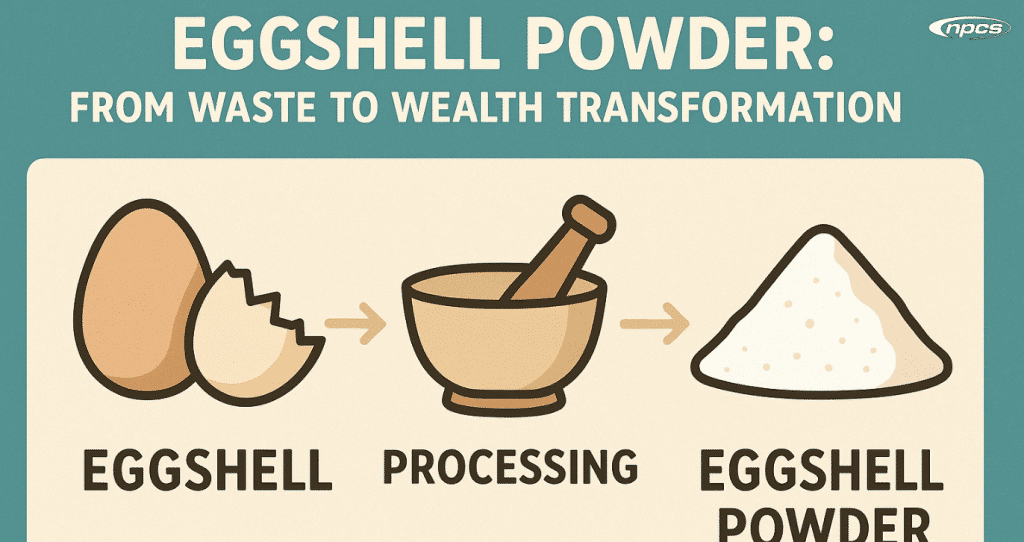In recent periods, there has been an increase in the sustainability of agricultural and food wastes. From these innovations, egg shell powder production is by far the best example with the possibility of converting waste egg shells into valuable products. This paper provides the entire process of how egg shell powder is manufactured, the machinery involved, automation opportunities that can be applied to streamline production, and the vital qualities and safety standards.
Understanding Egg Shell Powder and Its Importance
The egg shell powder is essentially ground powder of dried eggshells. It is a fine powder high in calcium carbonate which is popularly used in animal feeds, pharmaceuticals, food supplements, and even cosmetics. Recycling these shells would therefore lead to less environmental wastage in industry and profit from a good by-product, turning waste into wealth.
Complete Manufacturing Process of Egg Shell Powder
The different steps undertaken in the manufacturing process of egg shell powder go into ensuring a high standard of purity, quality, and even safety. Here is the entire detailed stepwise process:
1. Collection and Washing
The first process is the collection of the raw egg shells at poultry farms or any kind of processing unit. The shells are usually dirty and carry some egg white residues, dirt, and microbes. Washing them properly in water with mild detergents sometimes gets rid of the contaminants, making the shells ready for the subsequent stages.
2. Drying
Immediately after washing, you dry the wet shells to reduce their moisture content. You can dry them either by using natural sun drying or by using industrial dryers like tray dryers or rotary dryers. Proper drying will prevent growth of microbes and facilitate grinding.
3. Grinding
Dried, then the eggshells are fed into grinding machines which crush them into small-sized powder. The quality of the grinding machine will affect the size as well as the uniformity of the egg shell powder. It usually employs hammer mills, ball mills, or pulverizers.
4. Sieving
Upon grinding, the powder is passed through sieves for the separation of coarse particles and fine ones. The sieving process ensures that the egg shell powder conforms to the desired specifications in particle size.
5. Ownership
You would use moisture-proof packaging materials, like polyethylene bags or multilayer laminates, for the final packaging of egg shell powder, thereby ensuring the quality of the powder during its storage and transport.
Machinery Used in Egg Shell Powder Production with Specifications
The choice of machines to use is very important with respect to the efficiency and quality of production of egg shell powder. There is a list of some machines commonly used in the manufacturing processes:
| Machinery | Function | Specifications |
| Egg Shell Washer | Cleaning shells | Capacity: 500 kg/hr, Stainless steel material |
| Tray Dryer / Rotary Dryer | Drying shells | Temperature: 60-80°C, Capacity: 300 kg/hr |
| Hammer Mill / Pulverizer | Grinding | Motor Power: 5-15 HP, Particle size: 100-200 mesh |
| Vibrating Sieve | Sieving powder | Mesh size: 100-200 mesh, Capacity: 200 kg/hr |
| Packing Machine | Automated packaging | Bag size: 1-25 kg, Sealing type: Heat seal |
Layout Planning for Efficient Production
A well-designed plant layout not only cuts down on contamination but also promotes the smooth flow of materials through the plant. An ideal layout should begin with the washing section at the entrance to the plant, followed by drying, grinding, sieving, and packaging.
Automation vs. Semi-Automatic Setup in Egg Shell Powder Production
Automation
Fully automated plants use conveyor belts and control systems to integrate washing, drying, grinding, sieving, and packaging. This eliminates labor costs, increases production speed, and ensures the same quality in all products. Automation is recommended for large units of production.
Semi-Automatic
Semi-automatic setups entail manual loading and monitoring at different stages with machines assisting key processes. This is a very cost-effective alternative for small and medium-sized enterprises* (SMEs); however, this method is most probably going to have low throughput and require more labor.
Quality Control and Safety Norms in Egg Shell Powder Production
It is imperative to ensure that quality and safety are high for acceptance among consumers and adherence to regulations. Some of the critical elements are as follows:
- Tests for Microbiological Life: The egg shell powder should be free from bacteria and pathology.
- Moisture Content: Below 5% moisture is a factor which can predispose spoilage.
- Calcium Levels: Test every now and then for the presence of calcium carbonate as a concentration that becomes the standard for the particular product.
- Packaging Integrity: Food-grade packing to ensure that no contaminant gets into the packing.
- Safety in the Workplace: Exercise some safety protocols like dust control, protective gears for workers, and regular maintenance of equipment to keep the workers safe.
Conclusion
The egg shell powder demonstrates how we can convert agricultural waste into productive resources by using the most suitable manufacturing processes and technologies. Each of the stages-washing to the levels of packaging, will require specialized machinery and careful quality control. In the end, you ensure sustainable, profitable operations and strictly adhere to safety and quality standards, whether you choose automated or semi-automatic systems.
Rising awareness is driving the wide applicability of egg shell powder across industries, bringing good tidings for waste reduction and economic growth. Contact any of our experts to know or get help setting up a production plant for manufacturing egg shell powder.
Some More Links
Join With Us
Niir Project Consultancy Services
Related Blogs
Eggshell Powder Business: A Profitable Opportunity
Egg Shell Powder Processing Unit. Best Business to Start …
Join us on YouTube

